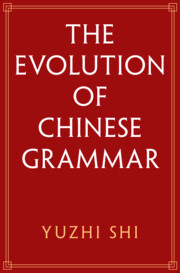Book contents
- The Evolution of Chinese Grammar
- The Evolution of Chinese Grammar
- Copyright page
- Dedication
- Epigraph
- Contents
- Figures
- Tables
- Acknowledgments
- Conventions Used in the Examples
- Abbreviations and Symbols
- 1 Some Preliminaries
- 2 Copular Word and Construction
- 3 Focus and Wh- Words
- 4 Serial Verb Construction
- 5 Disyllabification
- 6 Resultative Construction
- 7 Information Structure
- 8 The Passive Construction
- 9 The Disposal Construction
- 10 Verb Copying and Reduplication
- 11 The Comparative Construction
- 12 The Ditransitive Construction
- 13 Aspect and Tense
- 14 Negation
- 15 The Boundedness of the Predicate
- 16 Classifiers
- 17 Demonstratives from Classifiers
- 18 Distal Demonstratives from Phonological Derivation
- 19 Pronouns, Plurals, and Diminutives
- 20 Structural Particles
- 21 Word Order and Relative Clauses
- 22 Conclusions
- References
- Primary Sources of Texts
- Index
3 - Focus and Wh- Words
Published online by Cambridge University Press: 16 March 2023
- The Evolution of Chinese Grammar
- The Evolution of Chinese Grammar
- Copyright page
- Dedication
- Epigraph
- Contents
- Figures
- Tables
- Acknowledgments
- Conventions Used in the Examples
- Abbreviations and Symbols
- 1 Some Preliminaries
- 2 Copular Word and Construction
- 3 Focus and Wh- Words
- 4 Serial Verb Construction
- 5 Disyllabification
- 6 Resultative Construction
- 7 Information Structure
- 8 The Passive Construction
- 9 The Disposal Construction
- 10 Verb Copying and Reduplication
- 11 The Comparative Construction
- 12 The Ditransitive Construction
- 13 Aspect and Tense
- 14 Negation
- 15 The Boundedness of the Predicate
- 16 Classifiers
- 17 Demonstratives from Classifiers
- 18 Distal Demonstratives from Phonological Derivation
- 19 Pronouns, Plurals, and Diminutives
- 20 Structural Particles
- 21 Word Order and Relative Clauses
- 22 Conclusions
- References
- Primary Sources of Texts
- Index
Summary
As indicated in Chapter Two, during its history, Chinese underwent a dramatic typological change from being a rigid wh-movement language to being a complete wh- in situ language. Roughly speaking, in the period of Old Chinese, wh-words used as objects needed to be fronted to the preverbal position , though Chinese was an SVO language, like English . However, during the first half of Middle Chinese, wh- movements were gradually replaced by wh- in situ.
- Type
- Chapter
- Information
- The Evolution of Chinese Grammar , pp. 27 - 61Publisher: Cambridge University PressPrint publication year: 2023

